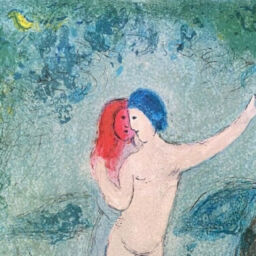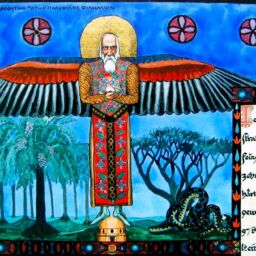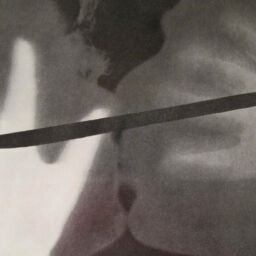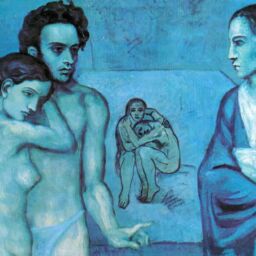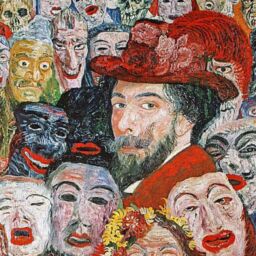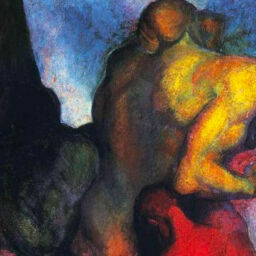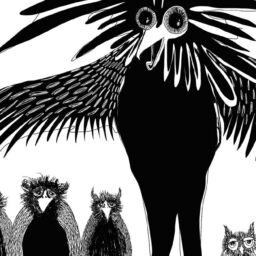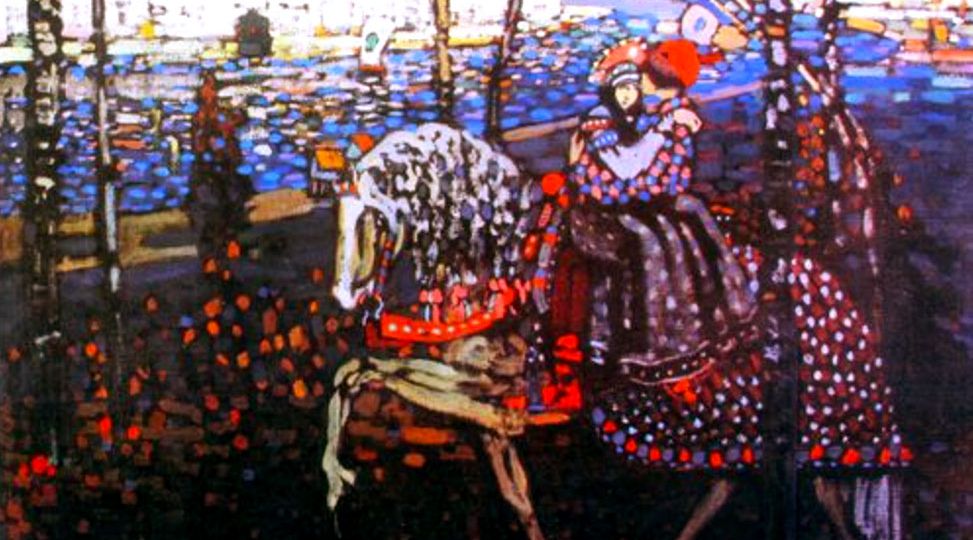
The End is a New Beginning
In Circulatio Perpetuum
Sam Allevato III, October 16, 2019

Fairytales are in-depth archetypal material swaddled in children’s clothing. Free of specific cultural content, they can mirror the basic patterns of the psyche to a greater extent than other literary products or even myths (von Franz, 1974/1995, p. 12) and can easily migrate across continents and time. The pure nature of fairytale reflects the archetypal patterning of human behavior and communicates in a simple form essential life lessons that are seemingly dreamlike but resonate upon a broader psychological plane. Therefore, the fairy tale was a perfect vessel for Rilke to communicate the essential mystery of the chymical marriage. Rilke knew that what proves to be most true may first be regarded as a dream. Using fairy tale, Rilke could take life lessons from deep waters of meaning and provide them in a professedly innocent story. In this sense, the reader is disarmed, allowing the fairy tale to mirror the most basic psychological structures without inhibition or unconscious defense mechanisms.
The Dragon lurks in the shadows of the tale, never emerging but moving us towards anima’s incontestable gift of soul. It has a mysterious connection to the Princess, may even be married to her in some way: “The more the girl grew and blossomed,” the closer to the “heart of the kingdom” the Dragon crept (Rilke, 1902/2019, ¶ 3). Thus, the Princess and Dragon are vitally connected on a fundamental level, dependent but yet repellent, alive in one way or another wanting to be imagined into being. Rilke (1904/2012) once said, “Perhaps all the dragons in our lives are princesses who are only waiting to see us act, just once, with beauty and courage. Perhaps everything that frightens us is, in its deepest essence, something helpless that wants our love” (p. 63). The fairy tale explains the principle at work here:
For there is a secret connection between the most Beautiful and the most Terrible things, just as there is between mountain peaks and abysses, between calm lakes and the rushing streams that feed them, between noble, laughing Life and the dark Death that lies near us all the time. (Rilke, 1902/2019, ¶ 3)
Thus, Rilke’s tale does not imply “that the Dragon harbored hostility towards the young Princess just as no one of conscience and honor can say whether Death is opposed to life” (Rilke, 1902/2019, ¶ 4). A refusal to consider opposing states as oppositional links the power of anima transformation with the heroic task of facing one’s shadow, and the Princess to the Dragon. The Dragon’s lack of hostility to the Princess makes it a symbolic representation of the shadow and transformative vessel intimately linked to anima imagery. Shadow is defined as the personification of certain aspects of the unconscious personality (von Franz, 1974/1995, p. 3). The shadow is only part of the human psyche but always present. The more one disregards what is to remain in shadow, the fiercer it becomes. Like a dragon, it transforms into an autonomous agent of reformation, demanding inspection within or acting out as fate without. The shadow’s mysterious paradox is that although it may remain unknown, it devours any attempt to keep it concealed from others.
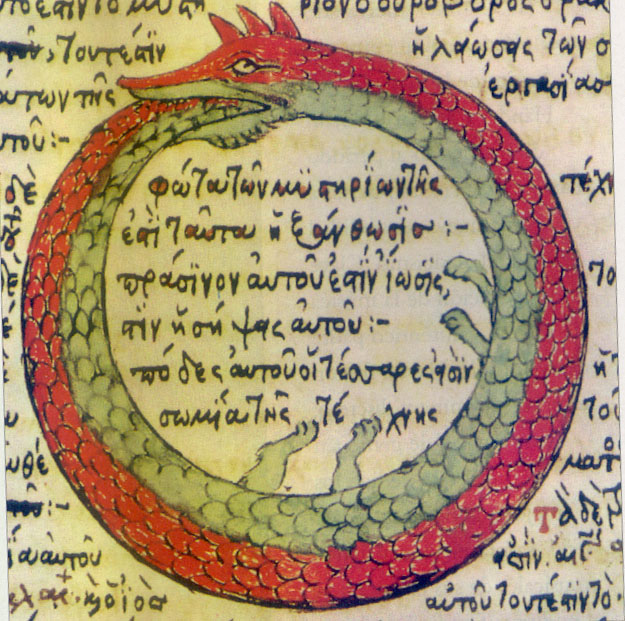
The alchemical marriage is brought about through the hero function giving way to the anima function, initiating one to the underworld of unconscious psychic content. Jung wrote, “The anima usually contains all those common human qualities which the conscious attitude lacks” and mostly rejects (1921/1971, ¶ 804). The relation with the anima is a test of courage, “an ordeal by fire for the spiritual and moral forces of man” (1954/1968, ¶ 61), for when dealing with the anima we are dealing with psychic facts that have remained “outside” of us in the form of projections. Both anima and animus share the embodiment of nature’s perennial propensity towards transformation. Similarly, anima and animus are powerful and feminine, devouring yet redeeming, enshadowed though ever present. Rilke’s tale is a clue to his unyielding search for true love and a confession of his relationship to anima’s formidable strength.
The world of Rilke’s tale, like many fairy tales, is one besieged by the Dragon. This is the world of the wasteland, where people are living inauthentic lives. In most fairy tales, a successful hero is the answer to the wasteland. Rilke, however, presents the tale not as a deliverance from the Dragon but rather as a slow descent into the shadowy realm of the Dragon. Rilke refers to the slayer of the Dragon in a variety of ways, not as Hero per se but as “rider,” “trembling hero,” “rescuer,” “strange hero,” and “the one who freed the land.” In fact, when the slayer appears, he seems ordinary. By contrast, the Dragon strikes fear into the King’s people: “No matter if such were a child or simple shepherd, it would fall upon them like the spectre of Death itself and destroy them so no trace of warm life survived” (Rilke, 1902/2019, ¶ 4). The King promises anything, including his daughter, to be free from the formidable force of the devouring serpent.
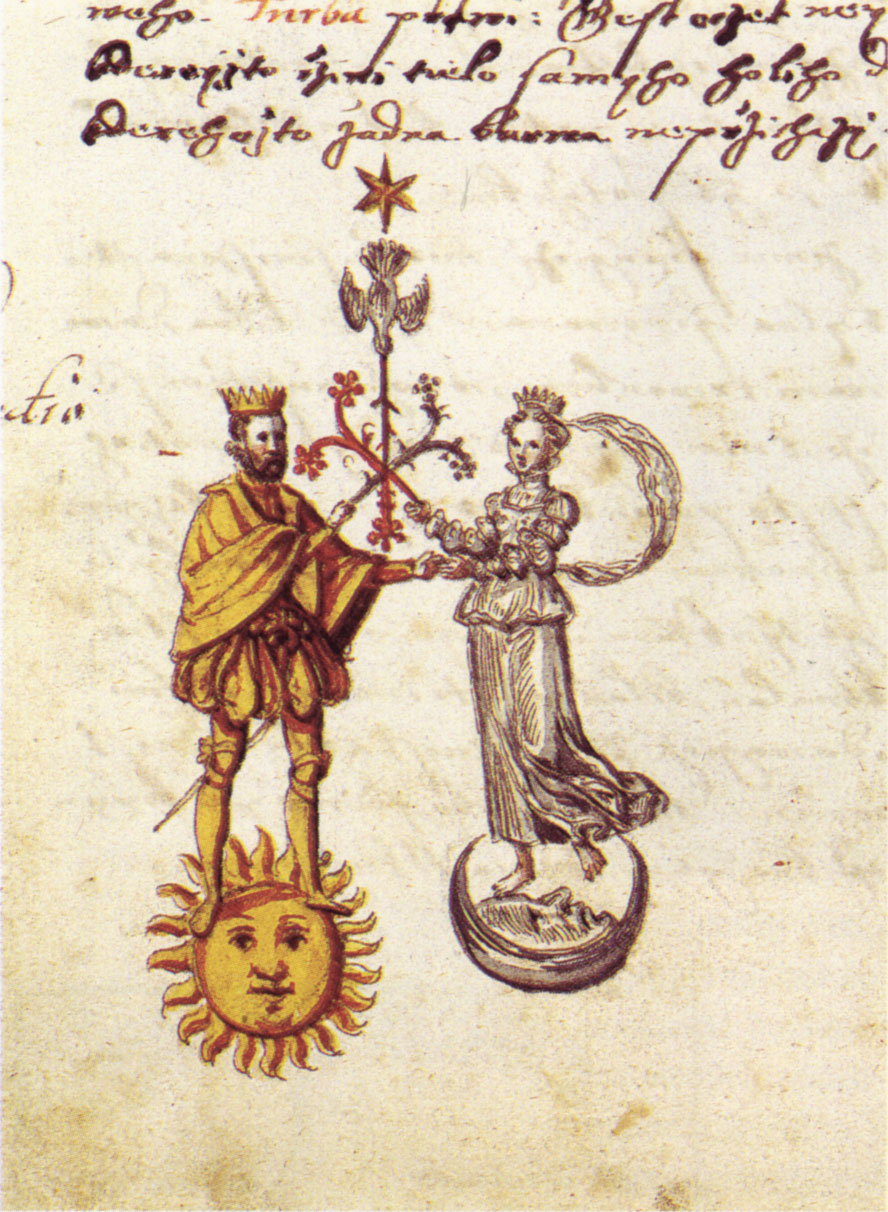
Rilke clearly understood the unmistakable power and transcendent redemptive potential in the relationship between opposites as an alchemist understood the importance of sulfur to gold, light to dark, and life to death. The King represents ego-consciousness while the Princess can be seen as the feminine aspect of soul or psyche trapped between consciousness and unconsciousness, only to be redeemed by the animus. Rilke (1905/2005) wrote the following in his Book of Hours: “You said live out loud, and die you said lightly, / And over and over again you said be” (p. 59). The synchronous observation of polarities potentiates a new thing, the third space of congruency of the outer and inner life. Rilke sets the kingdom in this realm of transcendent perception pregnant with death’s redeeming riches. With these words, we step out of reality and into the field of imagination. It is the kingdom of transformation, and Rilke choreographs the nexus with Mercurius duplex dancing between both worlds. The medial space is where life’s meaning is borne and the warp and weft of soul-making spun.
Many, as Rilke described, came and died at the fate of Dragon’s increasing threat. At first, “The King remarked with great satisfaction how this great danger and the need it announced made so many youths into men.” He hoped that one of them “should succeed in freeing the land from the great Death and restore joy and commerce to its sad, eerily deserted streets” (Rilke, 1902/2019, ¶ 5). But very soon his satisfaction waned as the numbers of dead heroes increased. Initially, the Princess desired and prayed for the demise of the beast. She felt the effects of the dystopian wasteland; she “had never been so alone.” But then the Princess began to have dreams. In her dreams, the Princess’s heart “bound itself to the Dragon” and she called upon the “holy women” to defend it. Upon waking she felt shame. Shame is the chief calling card of the anima/animus as it is the part of ourselves that we wish to remain entombed under lock and key. This signals an awakening of the Princess’ animus and confrontation with the Dragon of the unconscious. From here on there is no hope of keeping the Dragon imprisoned in the shadow.
The Princess heard of a hero’s near-defeat of the Dragon. He was very young, of unknown origins, and barely able to tell of his escape from the maw of Death. Though he sustained severe wounds, he was able to crawl for a day and night to a cabin in the woods, leaving his horse to the vengeful Dragon. The Princess passionately desired to visit the hero and personally witness his valor, but when she saw her “sorrowful face coming and going in the many mirrors of the palace,” she could not bring herself to venture beyond the castle walls, signaling the ego’s abject terror before the unconscious. Instead, she sent her elderly servant three times to bring the hero “costly salves.” The Princess’s hesitation can be viewed as a desperate act of regression to restore the familiar amid troubled times. The Princess intuited her fateful journey but chose not to descend into the abyss that awaited her.

The Princess experienced death first-hand and emerged from the cabin which served as an alchemical alembic like the belly of a devouring serpent; she was alone in the dark woods. The Dragon was no longer a concern for her: “The quiet stillness did her good and healed her eyes” (Rilke, 1902/2019, ¶ 13). Leaving the cabin, she noticed the solitude of the metamorphic vessel surrounded by tall trees like an imaginary bridge linking earth to heaven. “She began to walk, leaving it to her feet to find the path.” This statement is indicative of a pilgrim’s reliance upon her feet, not her head, for wisdom. For the pilgrim, it is the one who travels furthest who has become most wise. Listening to instinctual wisdom avails the initiate of complex archetypal wisdom that a heart is subtle enough to grasp. Once outside, the Princess heard the song of a nightingale:
It was only the first half of the song, a short, sobbing question that the bird raised again and again. She knew no answer to it. And the voice, which had sounded so blissfully soft and mild in the garden, was much too loud, as if it belonged to some terrible bird whose nest rested in the crown of tall oaks. (Rilke, 1902/2018, ¶ 14)

The “very young man” had failed as hero, but he helped the Princess fish up a precipitous power of wholeness from the unconscious, which proved the more heroic act than had he been successful. The Princess was reborn into a new awareness. She felt lonely, “cut loose from life,” and witnessed herself in a new place of existence. Had she died? The initiatory journey has this effect, leaving the initiate in a new state of awareness, indicating the arrival of rebirth. Life as she once knew it seemed very far away. This new position was disorienting for the Princess, indicated by reflection: “When she thought for a moment, she no longer recognized the past, nor could she conceive of a future.” The sea of uncertainty the Princess felt represents her spiritual growth and initiation into the eternal. A Rigveda hymn, cited by Jung (1954/1968) speaks to this initiatory mystery:
Darkness there was, concealed in darkness,
A lightless ocean lost in night.
Then the One, that was hidden in the shell,
Was born through the power of fiery torment.
From it arose in the beginning love,
Which is the germ and the seed of knowledge. (¶ 671)
It was wise to let her hero die and travel to the yonder shore with a kiss, for he was really not much more than the personification of a regressive infantile musing associated with romantic love.
This scene presents the Princess’s initiation and reveals the disorientation that accompanies authentic initiation. It is the dark night of the soul. Mircéa Éliade (1958) emphasized the importance of initiatory experiences when he wrote, “The hope and dream of these moments of total crises are to obtain a definitive and total renovation, a renewal capable of transmuting life. Such renewal is the result of every genuine religious conversion” (p. 135). Without the sense of hopelessness and despair, the initiate may still feel compelled to cling to familiar ways that prevent true transformation. Thus, religious rites in native cultures were always accompanied by the uncertainty of survival.
At this point, Rilke deviates from the classic fairy tale. When a rider appeared on horseback, sweaty and in disarray, the Princess shrank back into the shadow and cover of bushes, allowing the strange hero to pass without interruption. In a single moment, she knew he had slain the Dragon and freed the realm from its wasteland. The Princess easily found her way back to the castle, finding her worried old servant and the coming of morning. She slept, then awoke to a celebration. The realm was transformed into a joyous gala with bells that rang madly in the towers. She allowed her chambermaids to dress and adorn her and weave emeralds and pearls into her hair, moist to the touch. Amidst the din, the princess realized that the trembling hero would not return to claim his reward. The fairy tale marriage that she was being prepared for would not take place; instead, something deeper and more profound had befallen the Princess. The Princess’s life unfurled from within a new realization and a deeper sense of her true Self.
In this moment, the Princess realized a greater purpose and achieved her life’s goal. She individuated and integrated her animus. The Princess was free, but not as a result of the arranged marriage covenant. She had left the comforts of the King within the royal castle and discovered the meaning of life and death. There was no greater reward or suitor comparable to individuation and the sense of wholeness.

At the end of the story, the King still clung to ego consciousness, awaiting the slayer hero in rigid and serious fashion, just as ego unrelentingly clings to its place at the head of the table and atop the throne. In a mostly Cartesian world of “I think therefore I am,” many individuals remain closely associated with ego onesidedness, losing sight of the bridge to the phantasmal. Reestablishing the inner-connecting principle to these essential psychic functions requires a heroic act of self-realization, a process referred to by alchemists as the chymical marriage. Such integration of opposites lies at the universal or collective root of psychological life, not to be identified with the ego. During the clash of opposites, a new transcendent path can arise “from the union of conscious and unconscious contents” (Jung, 1958/1969, ¶ 131). However, in the absence of a connecting principle to self-contained otherness, intellectual hybris (ὕβρις), petrifaction through arrogance of consciousness, leads to isolation. This position makes individuation impossible.
A specific confusion arises from ego’s propensity to cling to causality, its quest for a rationale or “if-then” logic to avoid further calamity by exposure to a greater force at work. The ability to differentiate comes as the result of the crises, not prior to them. This is knowledge a posteriori, or knowledge from experience which is all too commonly forgotten in these days of puer abundance. In other words, a recalcitrant ego is not the cause of neurotic difficulties but is one of the pathological symptoms of an individual’s maladaptation to unconscious contents, as when one is faced with situations that one is not equipped to manage. Jung recognized that “people will do anything, no matter how absurd, in order to avoid facing their own souls (psyche)” (Jung, 1936/1968), ¶ 126). The treasure of the alchemists that results from individuation is hard to attain and uncommon (aurum non vulgi) because it is far too convenient to choose not to see it. In other words, there is no comfort in individuation, and to individuate is indeed a supremely uncomfortable endeavor. Nevertheless, to change one’s perspective from resistance to a voluntary act of surrender can bring joy in life changes. The solution is to find the immovable center and develop it in accordance with nature. Myths and fairy tales can model the quest for the inner life that will enable one to flow down the stream of human life like a human being rather than a robot or prisoner to one’s preferences.
Jung said, “If the encounter with the shadow is the ‘apprentice-piece’ in the individual’s development, then that with the anima is the ‘master-piece’” (1954/1968, ¶ 61). This position archetypally anchors shadow and anima to the collective unconscious and posits a path to individuation through the anima, the transpersonal contrasexual aspect of the masculine psyche, or animus, the transpersonal contrasexual aspect of the feminine. Jung’s innovative perspective was visionary in recognizing the equal importance of both sexes and establishing each as necessary to its opposite. Without including the opposite sexual orientation, one cannot wholly transcend a one-sided psychological perspective. In dealing with the anima or animus, it is not sufficient to just know about these concepts and intellectualize them. Nor can we weave the stories of other people into ours through appropriation. Anima/animus are archetypes and, as such, complexes experienced outwardly as fate, suffered in the most personal facets of life. As provocateur, the anima no longer signifies “princess” but our worst private calamity or our best misadventure.
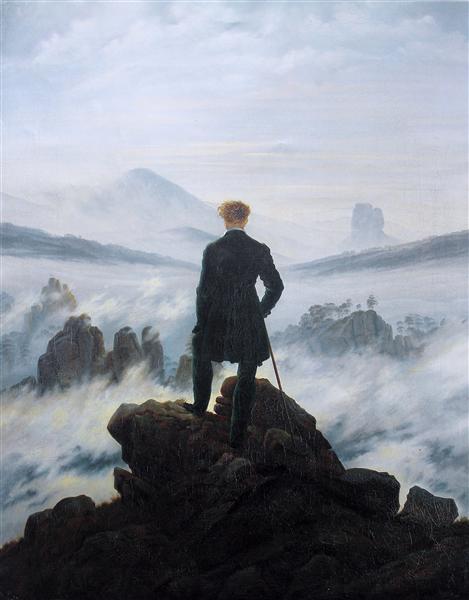
Fairy tales, like alchemy, capture an essence of the vital interplay between imagination and reality, chaos and union, and their transformative potentials. Anima is the connecting force between that which seriously impairs the fate of the adult and that which spurs him on to his highest potential. Rilke’s unique fairytale can help us with the mythic disorder of life—firstly to accept and appreciate areas of extreme turbulence within conscious life, and secondly to re-collect and then reexamine age-old romantic projections that we unconsciously nurture. Applying ancient wisdom in this way enables us to become more conscious, whether single or in a relationship, and provides new meaning and depth to inner-relationships. Chaotic pieces of psychic material, like the mysterious waters flowing through fairy tales, are part of the individuating self which continue to reveal her precious message in circulatio perpetuum. Rilke’s poem “The Woman Who Loves” is à propos:
Those times: the times when I was quite alone
By memories wrapt that whispered to me low,
My silence was the quiet of a stone
Over which rippling murmuring waters flow.
(Rilke, 1918/2012, p. 79)
Such moments contain the indispensable components of transformation lying just beneath the surface of consciousness; they form a cycle that gives way to light and reveals the new beginning found only at the end.
References
Éliade, M. (1958). Rites and symbols of initiation: The mysteries of birth and rebirth. Woodstock, CT: Spring Publications.
Eliot, T. S. (1942). East Coker. London: Faber and Faber.
Jung, C. G. (1968). Individual dream symbolism in relation to alchemy (R. F. C. Hull, Trans.). In H. Read et al. (Eds.), The collected works of C. G. Jung (Vol. 12, 2nd ed., pp. 39-224). Princeton, NJ: Princeton University Press. (Original work published 1936)
Jung, C. G. (1968). Religious ideas in alchemy (R. F. C. Hull, Trans.). In H. Read et al. (Eds.), The collected works of C. G. Jung (Vol. 12, 2nd ed., pp. 225-483). Princeton, NJ: Princeton University Press. (Original work published 1937)
Jung, C. G. (1968). Archetypes of the collective unconscious (R. F. C. Hull, Trans.). In H. Read et al. (Eds.), The collected works of C. G. Jung (Vol. 9, pt. 1, 2nd ed.). Princeton, NJ: Princeton University Press. (Original work published 1954)
Jung, C. G. (1969). The transcendent function (In R. F. C. Hull, Trans.). In H. Read et al. (Eds.), The Collected Works of C. G. Jung (Vol. 8, 2nd ed., pp. 67-91), Princeton, NJ: Princeton University Press. (Original work published 1958)
Jung, C.G. (1971). Psychological types (R.F.C. Hull, Trans.) (H. Read et al., Eds.), The collected works of C.G. Jung (Vol. 6). Princeton, NJ: Princeton University Press. (Original work published 1921)
Polikoff, D. J. (2011). In the image of Orpheus: Rilke—a soul history. Wilmette, IL: Chiron.
Rilke, R. M. (2019). The dragon slayer (D. J. Polikoff, Trans.). Personality Type in Depth, 38, October. (original work published 1902)
Rilke, R. M. (2005). Rilke’s book of hours: Love poems to god. (A. Barrows and J. Macy, Trans.). New York, NY: Riverhead Books. (Original work published 1905)
Rilke, R. M., Kappus, F. X., & Mitchell, S. (2012). Letters to a young poet. United States: Merchant Books. (Original work published 1929)
von Franz, M-L. (1995). Shadow and evil in fairy tales. Boulder, CO: Shambhala. (Original work published 1974)
Images
Friedrich, C. D. (1818). The wanderer above a sea of fog. Retrieved from wikiart.org
Griemiller, J. (1578). Chemical marriage between Sun and Moon, from the Rosarium Philosophorum. Retrieved from commons.wikimedia.org
Kandinsky, W. (1906). Couple riding. Retrieved from wikiart.org
Katarrhaktes (2008). The Katarrhaktes ouroboros. Retrieved from commons.wikimedia.org
Nollius, H. (1617). Rebis from the Theoria Philosophiae Hermeticae. Retrieved from commons.wikimedia.org
Picasso, P. (1902). Melancholy woman. Retrieved from wikiart.org
Serpiente alquimica from a late Byzantine Greek alchemical manuscript [drawing]. (1478). Retrieved from commons.wikimedia.org



